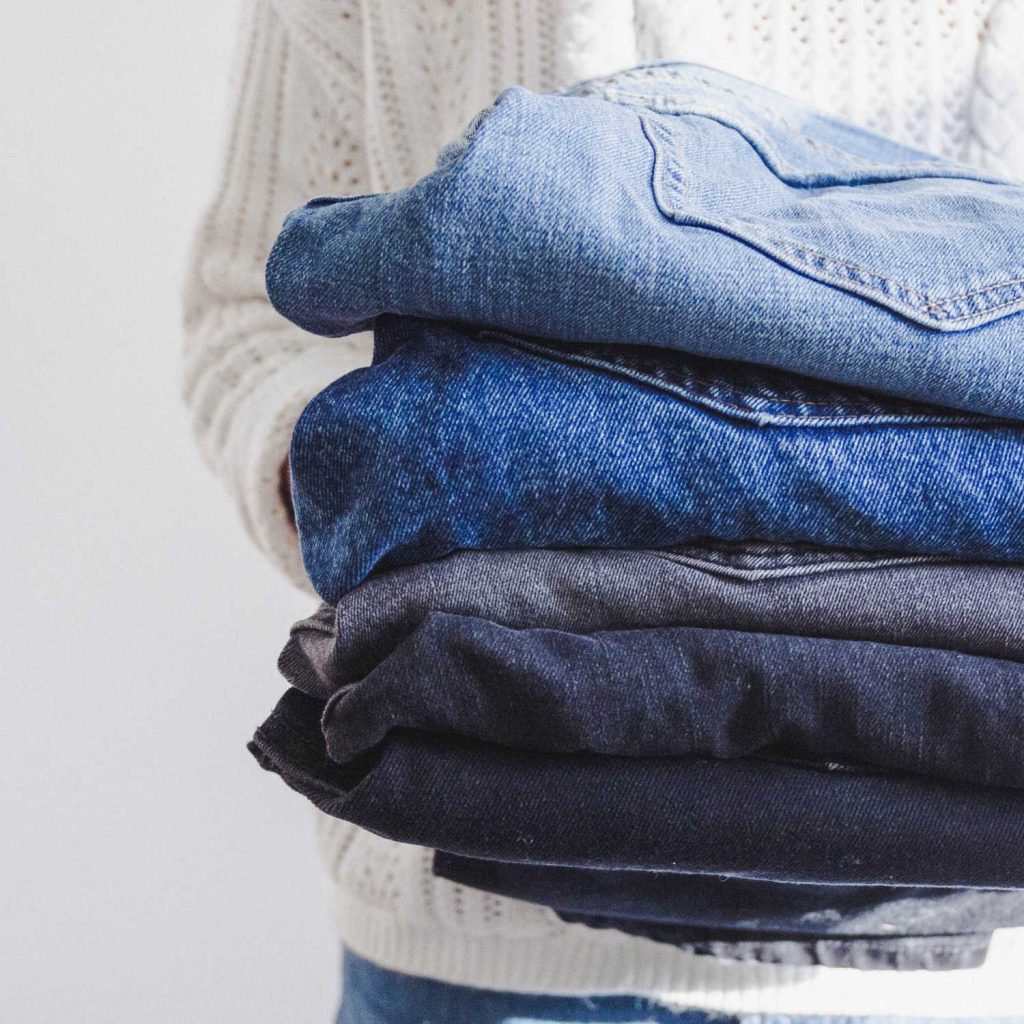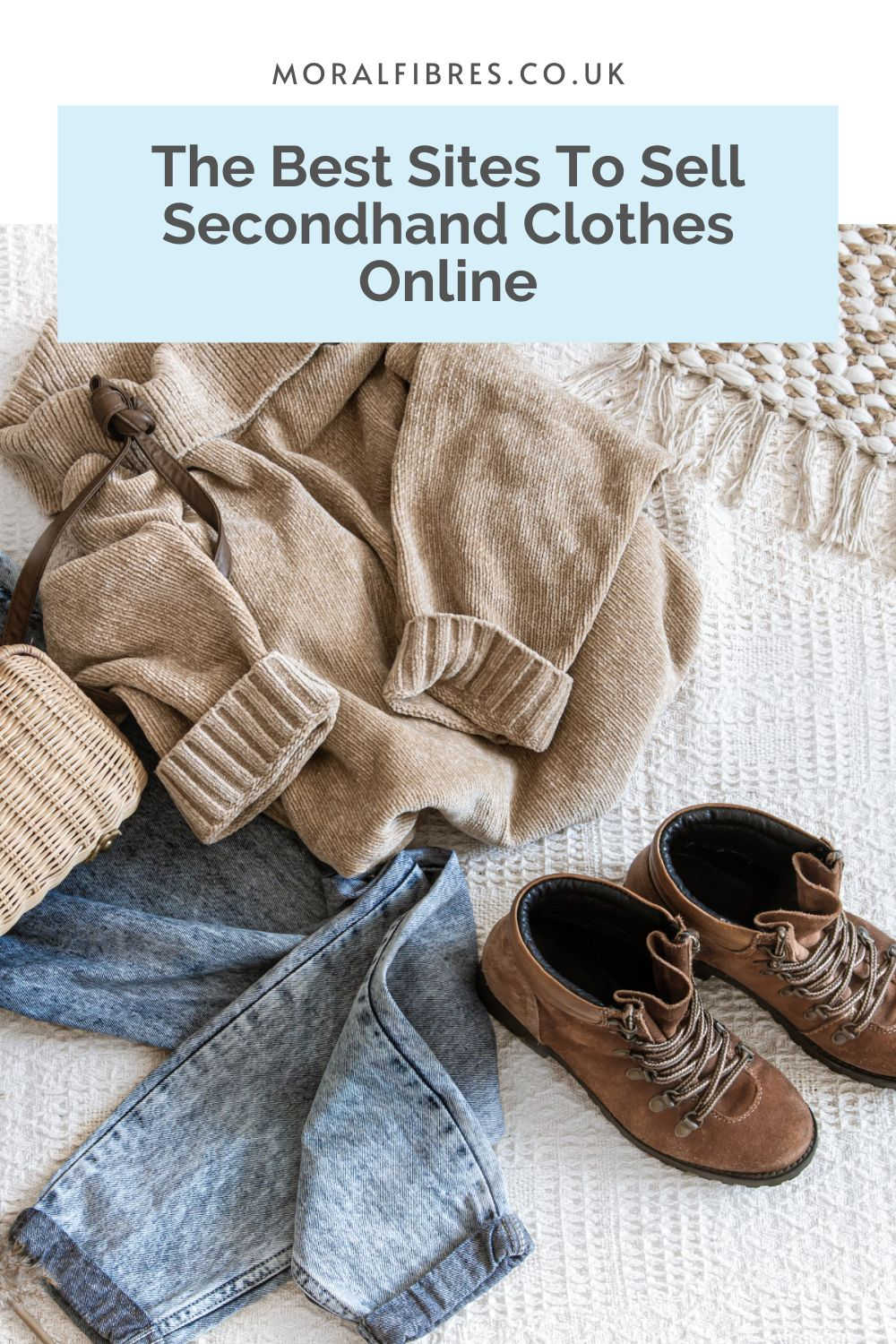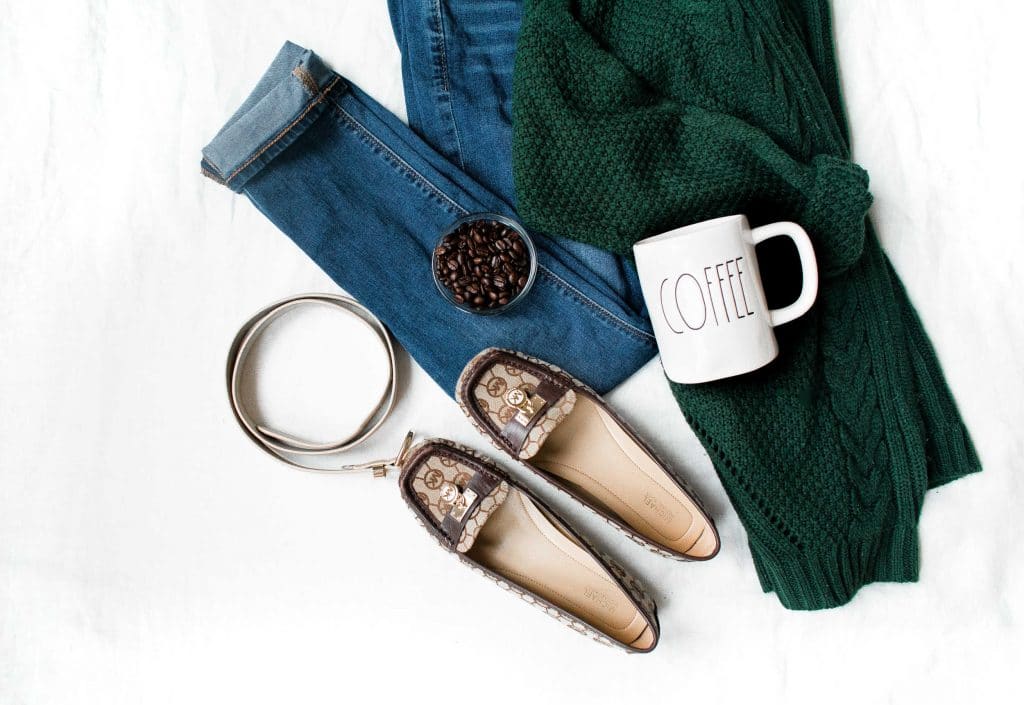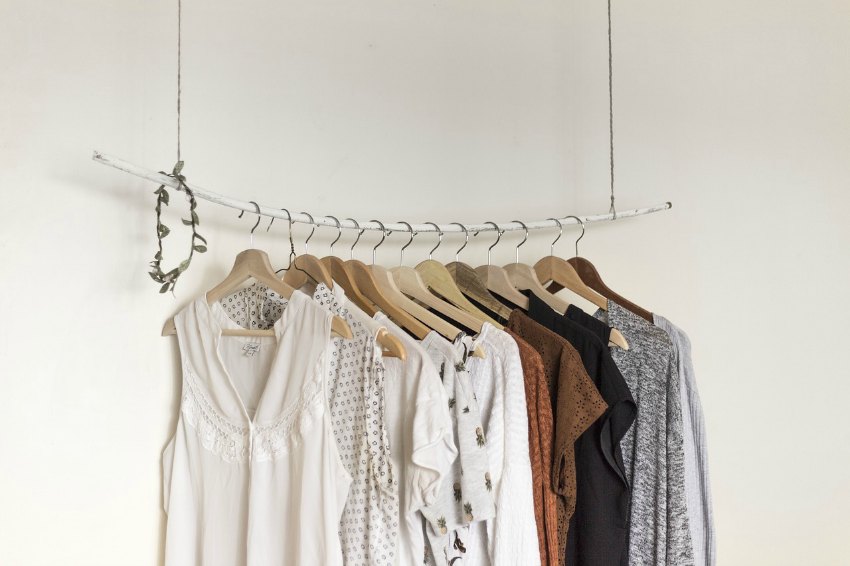The Best UK Sites To Sell Secondhand Clothes Online In 2024
To support the running costs of Moral Fibres, this post contains affiliate links. This means Moral Fibres may earn a small commission, at no extra cost to readers, on items purchased through these links.
Looking for the best sites to sell your secondhand clothes online for extra cash? Read on for my top recommendations.
I’ve written before about where to buy secondhand clothes online. But what about where to sell secondhand clothes online?
You might be thinking that the most sustainable thing to do is to donate your unwanted clothes to your local charity shops. However, it’s a not-so-well-known fact that charity shops can’t always sell what we donate to them. Therefore, selling secondhand clothes online can be more sustainable than dumping all your old clothes at your local charity shop.
So let’s take a look at what happens to our clothes when we donate them to charity shops, or via clothing banks or doorstep collection bags. Then I’ll take a look at some of the best places to sell your secondhand clothes online, to ensure they remain in active use.
If you’re in a hurry, use these quicklinks to the best resale sites in the UK:
Where Do Our Clothes Go When We Donate Them to Charity Shops?

We donate our unwanted clothes to charity shops and they sell all of our donations in their store, right?
Unfortunately, this isn’t the case. It certainly used to be the case up to around 20 years ago. So what happened? Fast fashion happened. The number of garments being produced has doubled in the last 20 years. At the same time, the cost of clothing has plummeted.
This exponential rise of cheap fast-fashion clothing has meant that clothing is now viewed as a disposable commodity. What this in turn means is that our charity shops are flooded with cheap, poor-quality clothing that nobody wants. What’s more, these items of clothing can’t be sold at a price that makes money for the charity shop.
Dr Andrew Brooks, author of the book Clothing Poverty says that the majority of the clothes we donate to charity shops now won’t be sold in the store. Instead, they will be traded abroad for profit.
In an interview with the BBC, he says:
“I think there is a common presumption amongst the general public that if they give something to charity it’s most likely to be sold in one of these shops. And while many garments are sold in these shops, the demand is relatively low compared to the supply, and far more get exported overseas.”
In fact, in the same interview, it is cited that more than 70% of all UK reused clothing donated via charity shops, clothing banks, and doorstep collection bags heads overseas.
Once it arrives overseas, it is chopped up into rags, sold at markets, or thrown into landfills.
The Impact of the International Trade on Secondhand Clothes
Where secondhand clothing is sold at markets, it has a negative effect on local textile industries in many countries. In Sub-Saharan Africa, where a third of all globally donated clothes are sold, Dr Andrew Brooks found the impacts of the secondhand clothing industry have been devasting for these local textile industries.
In Ghana, for example, he cites that textile and clothing employment fell by 80% between 1975 and 2000. Meanwhile, he also cites that Nigeria’s 200,000-person textile workforce has all but disappeared.
The Rag Trade
Where clothes can’t be sold, they get recycled into rags. The town of Panipat in North India recycles over 100,000 tonnes of our cast-offs every year. So much so that it is known as the world’s “cast-off capital“.
What’s so utterly embarrassing is that the women of Panipat who shred these practically unworn garments have surmised that there is a water shortage in the Western world.
That’s because the mindless nature of our clothing consumption is so alien to them, that they assume it’s too expensive for us to wash our clothes. This is the only way for them to make sense of how we discard our clothing after only wearing it a handful of times.
It’s easy to point the finger at us consumers for buying so many items of clothing, that we barely wear. However, it’s important to remember that fast fashion companies are also complicit.
BooHoo alone adds over 100 new items per day to their website. At the time of writing, H&M’s new arrivals page displays 1697 new items of women’s clothing. These companies constantly push us to buy more and more, when it’s simply not sustainable to do so.
Where to Sell Your Secondhand Clothes Online

Reducing the number of clothes we buy is a great first step in having a more sustainable and planet-friendly wardrobe. However, no matter how considerate we are in buying new clothes, there will always be items that no longer fit us, no longer suit us, or are no longer suitable for the life we now lead. If you’re in the market to sell some of your secondhand clothes, then here are five ideas on where to sell online.
eBay
I’ve been selling secondhand clothes on eBay since 2005. Whilst there have been lots of changes since 2005, I still rate eBay as a great place to sell secondhand clothes online, due to its huge global market.
Selling Options
eBay offers a range of selling options. You can list your clothing as a “buy it now”. This allows buyers to immediately purchase the item at a set price.
Alternatively, you can set a best-offer price, that allows buyers to haggle with you. Or you can list your item in eBay’s online auction. Here you can set a starting price of your choice, with an auction length of between one and ten days. If the item fails to sell in the auction, you can choose to automatically relist your item.
It’s really easy to sell on eBay – you can list items directly via the eBay app. Alternatively, you can take some photos and list them via your laptop/computer.
Fees
You generally don’t pay a fee to list your item on eBay. Instead, you pay a final value fee, based on the selling price of your item. This is 12.8% of the selling price of your item, including postage, and a 30p selling fee. This means that for an item of clothing that sells for £10, and has a £3 postage fee, eBay will take £1.96, leaving you with £11.04.
I have to say, it does irk me that eBay takes a cut of the postage costs because you aren’t allowed to charge more than the actual postage cost of the item.
You can also give a percentage of your sale to charity, with eBay automatically doing that on your behalf.
eBay used to partner with PayPal, and you got paid before you posted your item. eBay has since parted ways with PayPal, and now they use their own in-house payment system.
This system isn’t as smooth as Paypal and now takes several days for the payment to clear. This means that you don’t get paid until after you have posted your item. eBay, however, tells you as soon as the buyer has paid for your item (don’t post your item until you get that confirmation).
Once you have received confirmation that the buyer has made payment to eBay, then eBay then guarantees that you will receive your money within two working days. So far, we’ve not had a problem with this new system.
Depop
Depop has really risen in popularity in the last few years, as one of the places to shop online for secondhand clothes, via its Instagram meets eBay format.
Selling on Depop is simple. Add some photos of your item and a description, and decide the price you want to sell at.
Depop takes 10% of the selling price of your item (including postage costs), and you get paid via Paypal as soon as your item sells. PayPal takes a transaction fee of 2.9% + £0.30 in the UK. This means that for an item of clothing that sells for £10 and has a £3 postage fee, Depop and Paypal will take £1.97, leaving you with £11.03. This makes Depop’s selling fees on par with eBay.
Again, Depop takes a cut of the postage, which I feel is unfair. And just to warn you, there seems to be a bit of Depop drama that I haven’t seen with eBay.
Vinted

Vinted is another new-ish secondhand clothing market, where anyone can list their clothes for sale.
What’s different about Vinted, compared to eBay and Depop is that there are no selling fees. Instead, the buyer pays a fee to buy an item, which varies based on the price of the item they are buying.
This means as a seller that you get 100% of the sale price of an item. The buyer also pays the postage costs, and Vinted doesn’t take a cut of this either.
Thrift+
Can’t stand the thought of taking photos of items, writing descriptions, dealing with buyers, and making trips to the post office? This is where Thrift+ comes in. They will do all of this leg work for you and donate a percentage of the profits to charity too.
If you have clothes to sell, Thrift+ will send you a pre-paid postage bag which you use to send your items to Thrift+. That’s the limit of what you need to do.
What Thrift+ Accepts
Thrift+ isn’t a panacea for solving your overflowing wardrobe woes. They have standards in place as to what they can accept, so you can’t offload Boohoo or Primark hauls.
They accept recognisable brands in the following categories:
HIGH-STREET BRANDS IN EXCELLENT CONDITION such as Boden, Topshop, Asos, & Zara
PREMIUM BRANDS IN GOOD CONDITION such as &Other Stories, Whistles, COS, Hobbs, Phase Eight, Reiss, North Face
DESIGNER BRANDS, WHICH CAN HAVE MINOR DEFECTS such as Kenzo, Chloe, Versace, Stella McCartney, Burberry, Missoni, Prada, Gucci
Everything Thrift+ sells also has to pass their quality assessment, so before you send in your clothes, please check that they are clean, in good condition, and are a brand they accept.
When an item fails their quality tests, they will donate them to their charity partners, and cannot return these items, so do be honest with yourself before sending in your items.
What Fees Do Thrift+ Charge?
As Thrift+ does all of the leg work for you, there is a higher charge for this service compared to other outlets. Thrift+ charges 33% commission per item, with a minimum fee of £5 per item sold. At least £1 per sale will go to your chosen charity.
Here are a few examples:
- For an item that sells for £30 – Thrift+, the charity, and the donor each receive £10.
- For an item that sells for £10 – Thrift+ charges £5, and the charity & donor each receive £2.50.
- And for an item that sells for £5 or less – Thrift+ donates £1 to charity (this is their minimum donation), and then the remainder of the sale price is used for Thrift+ fees to cover the cost of processing.
Thrift+ doesn’t charge anything upfront. Instead, fees are deducted from the sale amounts.
When your items sell, you have a few options to get paid. You can choose to be paid in cash directly into your bank account, once a month (a new feature that launched in March 2024). Alternatively, you can choose to earn Thrift+ credits, which you can then donate to your chosen charity, or you can choose to keep some or all of the credits to spend again on the Thrift+ site.
Vestiaire Collective
French-owned Vestiaire Collective specialises in designer labels.
You list your item free of charge on their site. Then, once your item sells you post it to Vestiaire Collective for authentication by their experts. Once authenticated, Vestiaire then sends it to the buyer.
It sounds a bit of a faff, but this authentication process makes buyers feel more confident buying pre-owned designer goods online. You may therefore earn more money selling designer items on Vestiaire Collective compared to other online sites.
It’s important to bear in mind that because of the authentication process, you don’t get paid as soon as your item sells. After authentication, your payment should arrive two to six days after that.
Vestiaire Collective charges a flat fee of £13 for all items up to and including £130. For items above £130, they take 15-25% of the sale price, depending on what you sell your item for.
Not sure what to price your item at? Vestiaire Collective has a handy resale calculator to help you price your item accordingly.
Should I Not Donate My Secondhand Clothes To Charity Shops?

I’m not saying that we should never donate to charity shops. I think we should be more considerate of what we are donating.
It’s important to remember that just because a charity shop is run by a charity doesn’t mean that there aren’t costs involved.
Most charity shops aren’t run 100% by volunteers. In most cases, the store manager is salaried. Meanwhile, there are rental costs, utility costs, and all the costs involved in running a business. Many charity shops have monthly sales targets that they need to meet to show that they are covering their running costs and contributing to the charity.
Cheap, poor-quality clothing is hard for charity shops to sell. What’s more, it doesn’t generate much profit. Because of the low margins, these are the types of clothing that are most likely to get sent abroad.
However, when you donate good quality and desirable clothing, this allows charity shops to sell the item in the store at a price that enables them to make money.
As with many of the problems caused by fast fashion, the solution all comes down to people with disposable incomes choosing to buy fewer items of clothing.
As well as that, it involves the people who can spend more on quality items of clothing that they will wear time and time again. The fast fashion industry, and the spill-off problems it creates, won’t change until those of us with disposable incomes slow our consumption patterns right down.
What About Used Clothes That You Can’t Sell?
Stained, ripped, holey, or other clothes in bad condition can’t be sold online. Charity shops wouldn’t want them either. However, there is no need for these items to go to landfill. Simply pop them in a bag marked as rags, and donate to your local charity shop.
The charity shop can sell these on to the rag trade. This way, the charity shop still receives some money. Meanwhile, textile recycling companies can recycle these unwanted items of clothing into useful products. Think fillings for use in mattress production, or for producing filling material for furniture padding, panel linings, loudspeaker cones, and car insulation.
Alternatively, check out my guide on what to do with old clothes you can’t donate and my guide on what to do with old jeans, for heaps of upcycling and recycling ideas.
Found this post useful? Please consider buying me a virtual coffee to help support the site’s running costs.




